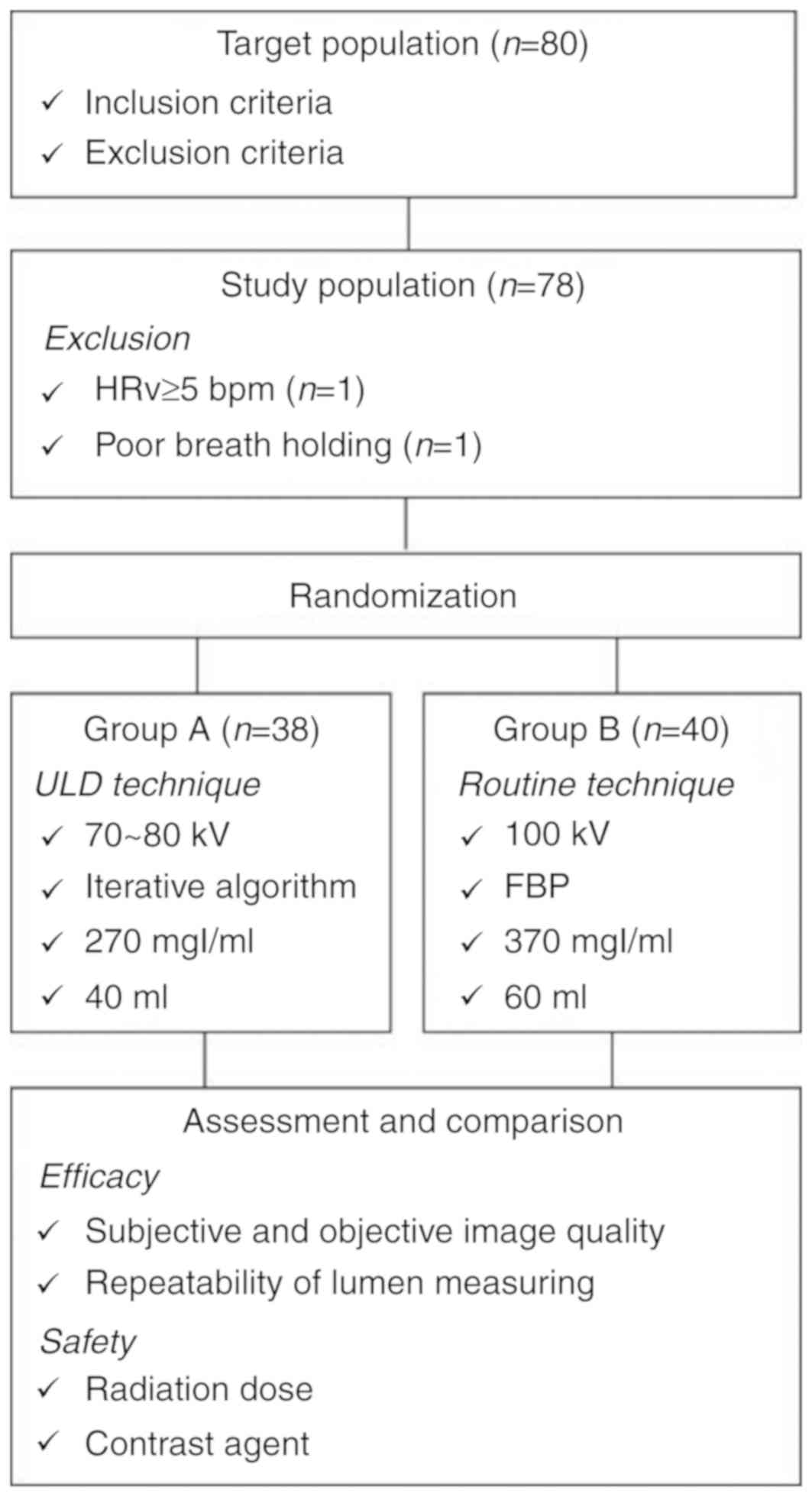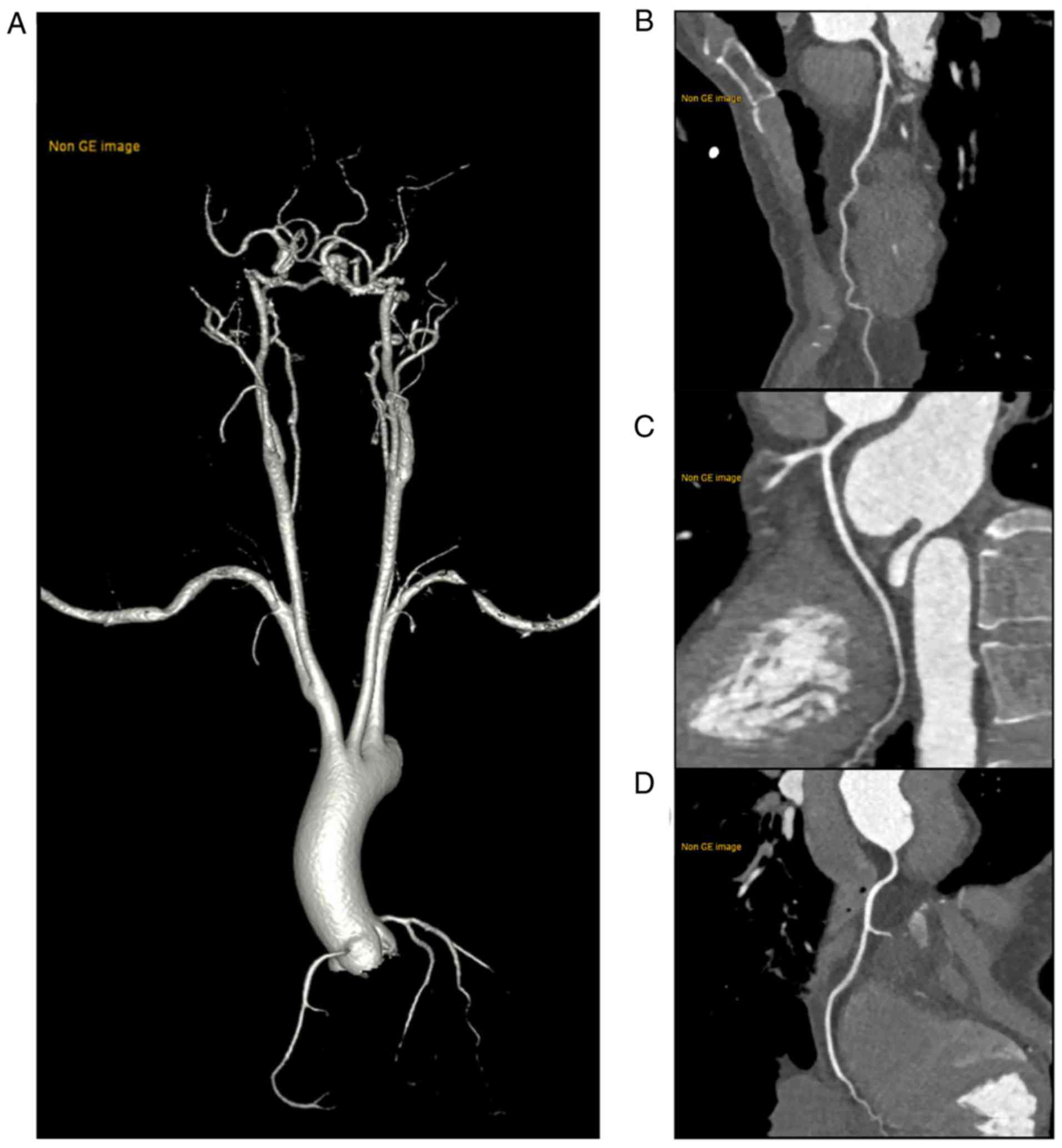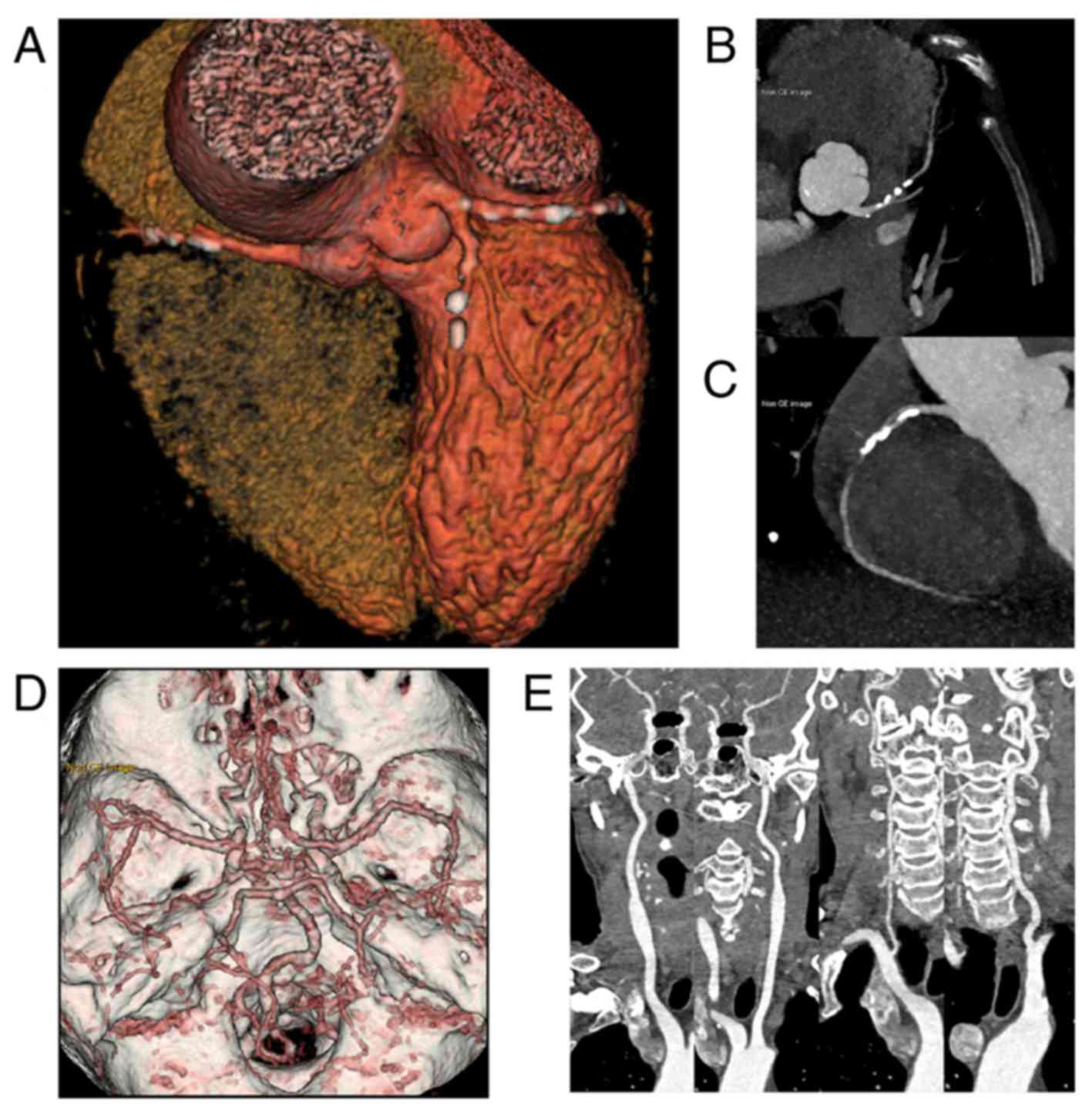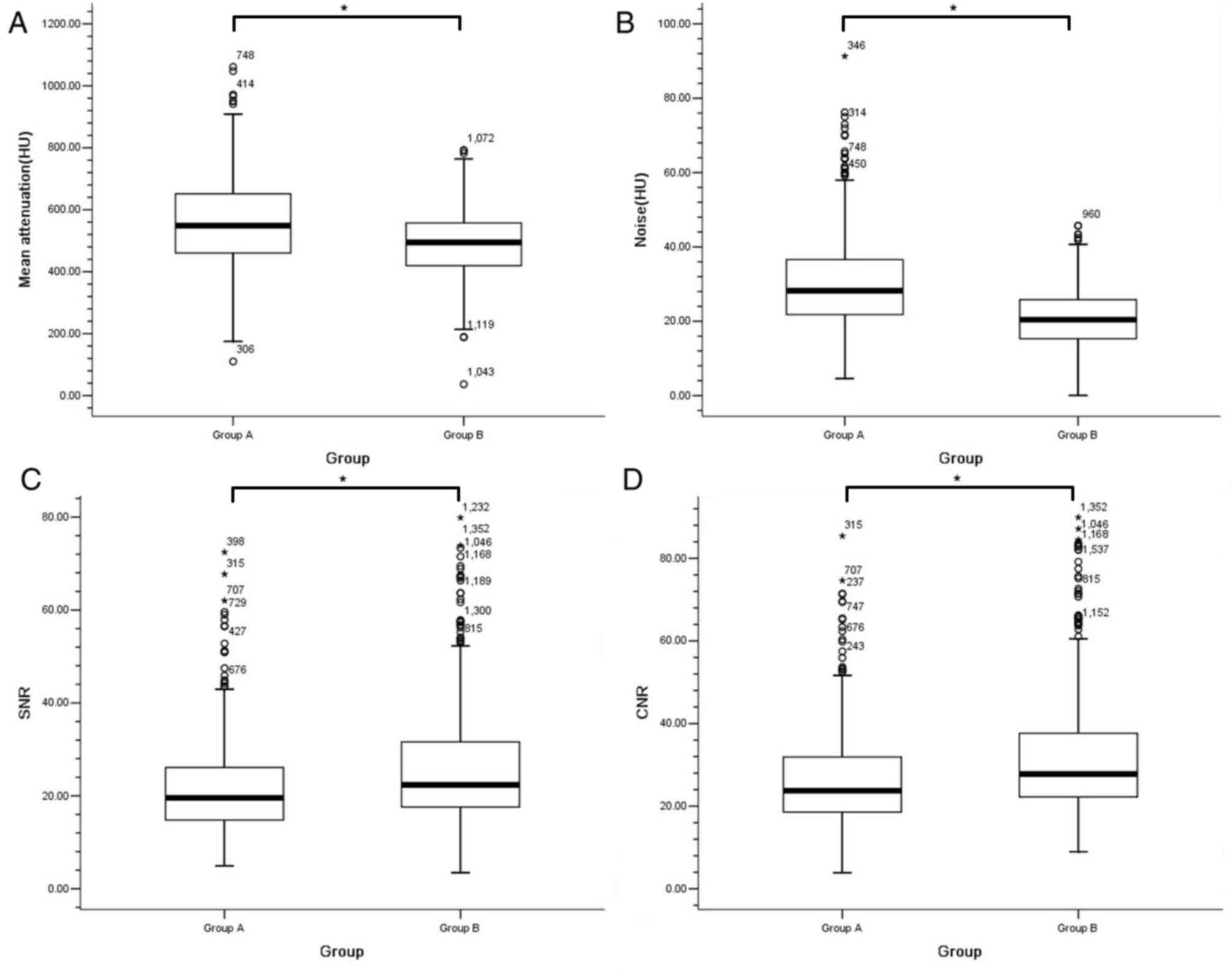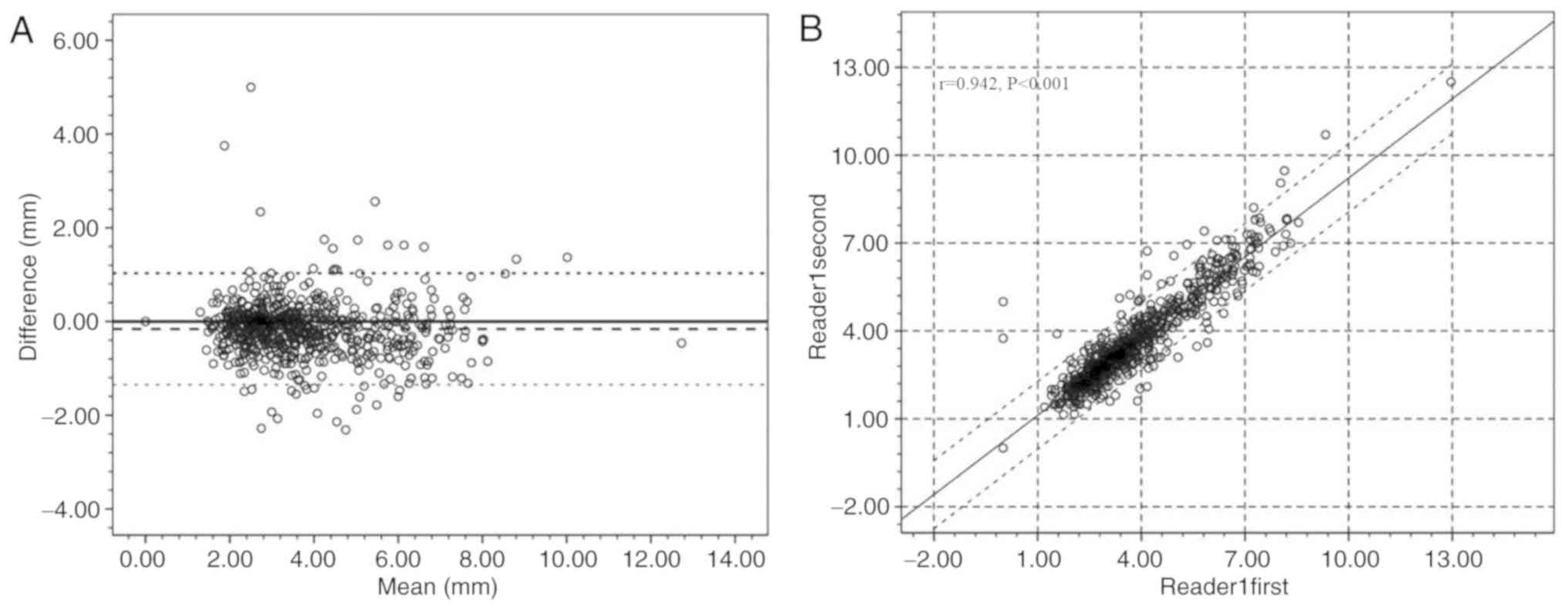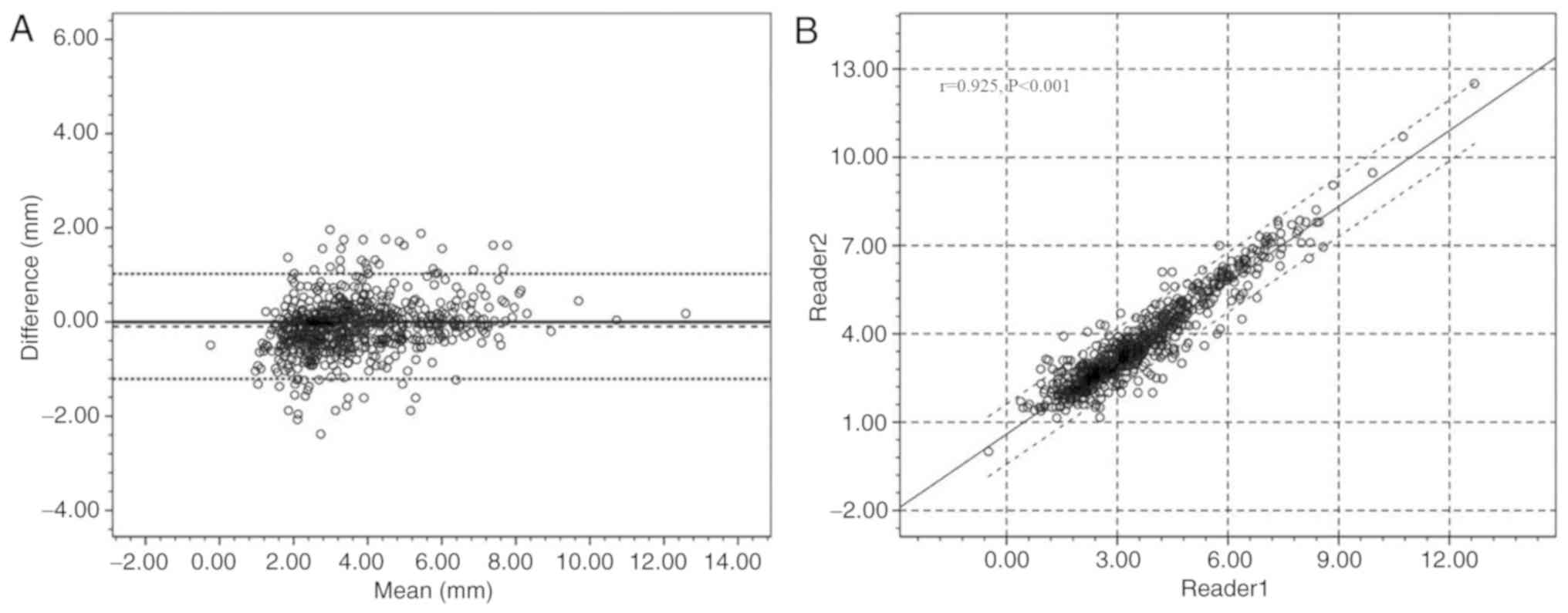|
1
|
Madisetty MK, Kumaraswami K, Katkam S,
Saumya K, Satyanarayana Raju Y, Chandra N, Jyotsna M, Patnaik S and
Kutala VK: Assessment of oxidative stress markers and carotid
artery intima-media thickness in elderly patients without and with
coronary artery disease. Indian J Clin Biochem. 31:278–285. 2016.
View Article : Google Scholar : PubMed/NCBI
|
|
2
|
Hamirani YS, Larijani V, Isma'eel H,
Pagali SR, Bach P, Karlsberg RP and Budoff MJ: Association of
plaque in thecarotid and coronary arteries: Using MDCT angiography.
Atherosclerosis. 211:141–145. 2010. View Article : Google Scholar : PubMed/NCBI
|
|
3
|
Li AH, Chu YT, Yang LH, Chen KC and Chu
SH: More coronary artery stenosis, more cerebral artery stenosis? A
simultaneous angiographic study discloses their strong correlation.
Heart Vessels. 22:297–302. 2007. View Article : Google Scholar : PubMed/NCBI
|
|
4
|
Coskun U, Yildiz A, Esen OB, Baskurt M,
Cakar MA, Kilickesmez KO, Orhan LA and Yildiz S: Relationship
between carotid intima-media thickness and coronary angiographic
findings: A prospective study. Cardiovasc Ultrasound. 7:592009.
View Article : Google Scholar : PubMed/NCBI
|
|
5
|
Zhou M, Wang H, Zhu J, Chen W, Wang L, Liu
S, Li Y, Wang L, Liu Y, Yin P, et al: Cause-specific mortality for
240 causes in China during 1990–2013: A systematic subnational
analysis for the Global Burden of Disease Study 2013. Lancet.
387:251–272. 2016. View Article : Google Scholar : PubMed/NCBI
|
|
6
|
Min JK, Edwardes M, Lin FY, Labounty T,
Weinsaft JW, Choi JH, Delago A, Shaw LJ, Berman DS and Budoff MJ:
Relationship of coronary artery plaque composition to coronary
artery stenosis severity: Results from the prospective multi center
ACCURACY trial. Atherosclerosis. 219:573–578. 2011. View Article : Google Scholar : PubMed/NCBI
|
|
7
|
Wang Q, Zeng Y, Wang Y, Cai J, Cai Y, Ma L
and Xu X: Comparison of carotid arterial morphology and plaque
composition between patients with acute coronary syndrome andstable
coronary artery disease: A high-resolution magnetic resonance
imaging study. Int J Cardiovasc Imaging. 27:715–726. 2011.
View Article : Google Scholar : PubMed/NCBI
|
|
8
|
Goetti R, Feuchtner G, Stolzmann P,
Desbiolles L, Fischer MA, Karlo C, Baumueller S, Scheffel H,
Alkadhi H and Leschka S: High-pitch dual-source CT coronary
angiography: Systolic data acquisition at high heart rates. Eur
Radiol. 20:2565–2571. 2010. View Article : Google Scholar : PubMed/NCBI
|
|
9
|
Leschka S, Stolzmann P, Desbiolles L,
Baumueller S, Goetti R, Schertler T, Scheffel H, Plass A, Falk V,
Feuchtner G, et al: Diagnostic accuracy of high pitch dual-source
CT for the assessment of coronary stenoses: First experience. Eur
Radiol. 19:2896–2903. 2009. View Article : Google Scholar : PubMed/NCBI
|
|
10
|
Sun K, Li K, Han R, Li W, Chen N, Yang Q,
Du X, Wang C, Liu G, Li Y, et al: Evaluation of high-pitch
dual-source CT angiography for evaluation of coronary and
carotid-cerebrovascular arteries. Eur J Radiol. 84:398–406. 2015.
View Article : Google Scholar : PubMed/NCBI
|
|
11
|
Wang Z, Chen Y, Wang Y, Xue H, Jin Z, Kong
L, Cao J and Li S: Feasibility of low-dose contrast medium high
pitch CT angiography for the combined evaluation of coronary, head
and neck arteries. PLoS One. 9:e902682014. View Article : Google Scholar : PubMed/NCBI
|
|
12
|
Zhang JL, Liu BL, Zhao YM, Liang HW, Wang
GK, Wan Y, Huang YH and Shen BZ: Combining coronary with carotid
and cerebrovascular angiography using prospective ECG gating and
iterative reconstruction with 256-slice CT. Echocardiography.
32:1291–1298. 2015. View Article : Google Scholar : PubMed/NCBI
|
|
13
|
Tognolini A, Arellano CS, Marfori W,
Heidari G, Sayre JW, Krishnam MS and Ruehm SG: Comprehensive
low-dose imaging of carotid and coronary arteries with a
single-injection dualsource CT angiography protocol. Clin Radiol.
69:246–253. 2014. View Article : Google Scholar : PubMed/NCBI
|
|
14
|
Zhang LJ, Qi L, Wang J, Tang CX, Zhou CS,
Ji XM, Spearman JV, De Cecco CN, Meinel FG, Schoepf UJ and Lu GM:
Feasibility of prospectively ECG-triggered high-pitch coronary CT
angiography with 30 mL iodinated contrast agent at 70 kVp: Initial
experience. Eur Radiol. 24:1537–1546. 2014. View Article : Google Scholar : PubMed/NCBI
|
|
15
|
Zhang LJ, Qi L, De Cecco CN, Zhou CS,
Spearman JV, Schoepf UJ and Lu GM: High-pitch coronary CT
angiography at 70 kVp with low contrast medium volume comparison of
80 and 100 kVp high-pitch protocols. Medicine (Baltimore).
93:e922014. View Article : Google Scholar : PubMed/NCBI
|
|
16
|
Schuhbaeck A, Achenbach S, Layritz C,
Eisentopf J, Hecker F, Pflederer T, Gauss S, Rixe J, Kalender W,
Daniel WG, et al: Image quality of ultra-low radiation exposure
coronary CT angiography with an effective dose <0.1 mSv using
high-pitch spiral acquisition and raw data-based iterative
reconstruction. Eur Radiol. 23:597–606. 2013. View Article : Google Scholar : PubMed/NCBI
|
|
17
|
Zhao L, Liu A and Guo Y: Ultra-low-dose CT
coronary angiography using 128-slice dual source CT with low
concentration contrast agent: Initial experience. Jpn J Radiol.
35:724–732. 2017. View Article : Google Scholar : PubMed/NCBI
|
|
18
|
Zheng M, Wu Y, Wei M, Liu Y, Zhao H and Li
J: Low-concentration contrast medium for 128-slice dual-source CT
coronary angiography at a very low radiation dose using
prospectively ECG-triggered high-pitch spiral acquisition. Acad
Radiol. 22:195–202. 2015. View Article : Google Scholar : PubMed/NCBI
|
|
19
|
Halliburton SS, Abbara S, Chen MY, Gentry
R, Mahesh M, Raff GL, Shaw LJ and Hausleiter J; Society of
Cardiovascular Computed Tomography, : SCCT guidelines on radiation
dose and dose-optimization strategies in cardiovascular CT. J
Cardiovasc Comput Tomogr. 5:198–224. 2011. View Article : Google Scholar : PubMed/NCBI
|
|
20
|
Austen WG, Edwards JE, Frye RL, Gensini
GG, Gott VL, Griffith LS, McGoon DC, Murphy ML and Roe BB: A
reporting system on patients evaluated for coronary artery disease.
Report of the Ad hoc committee for grading of coronary artery
disease, council on cardiovascular surgery, american heart
association. Circulation. 51 (4 Suppl):S5–S40. 1975. View Article : Google Scholar
|
|
21
|
Ghadri JR, Küest SM, Goetti R, Fiechter M,
Pazhenkottil AP, Nkoulou RN, Kuhn FP, Pietsch C, von Schulthess P,
Gaemperli O, et al: Image quality and radiation dose comparison of
prospectively triggered low-dose CTCA: 128-slice dual-source
high-pitch spiral versus 64-slice single-source sequential
acquisition. Int J Cardiovasc Imaging. 28:1217–1225. 2011.
View Article : Google Scholar : PubMed/NCBI
|
|
22
|
Masabni K, Sabik JF III, Raza S, Carnes T,
Koduri H, Idrees JJ, Beach J, Riaz H, Shishehbor MH, Gornik HL and
Blackstone EH: Nonselective carotid artery ultrasound screening in
patients undergoing coronary artery bypass grafting: Is it
necessary? J Thorac Cardiovasc Surg. 151:402–408. 2016. View Article : Google Scholar : PubMed/NCBI
|
|
23
|
Bae KT, Seeck BA, Hildebolt CF, Tao C, Zhu
F, Kanematsu M and Woodard PK: Contrast enhancement in
cardiovascular MDCT: Effect of body weight, height, body surface
area, body mass index, and obesity. AJR Am J Roentgenol.
190:777–784. 2008. View Article : Google Scholar : PubMed/NCBI
|
|
24
|
Lu B, Mao SS, Zhuang N, Bakhsheshi H,
Yamamoto H, Takasu J, Liu SC and Budoff MJ: Coronary artery motion
during the cardiac cycle and optimal ECG triggering for coronary
artery imaging. Invest Radiol. 36:250–256. 2001. View Article : Google Scholar : PubMed/NCBI
|
|
25
|
Adler G, Meille L, Rohnean A,
Sigal-Cinqualbre A, Capderou A and Paul JF: Robustness of
end-systolic reconstructions in coronary dual-source CT angiography
for high heart rate patients. Eur Radiol. 20:1118–1123. 2010.
View Article : Google Scholar : PubMed/NCBI
|
|
26
|
Goetti R, Baumüller S, Feuchtner G,
Stolzmann P, Karlo C, Alkadhi H and Leschka S: High-pitch
dual-source CT angiography of the thoracic and abdominal aorta: Is
simultaneous coronary artery assessment possible? AJR Am J
Roentgenol. 194:938–944. 2010. View Article : Google Scholar : PubMed/NCBI
|
|
27
|
Lembcke A, Schwenke C, Hein PA, Knobloch
G, Durmus T, Hamm B and Huppertz A: High-pitch dual-source CT
coronary angiography with low volumes of contrast medium. Eur
Radiol. 24:120–127. 2014. View Article : Google Scholar : PubMed/NCBI
|
|
28
|
Ertl-Wagner BB, Hoffmann RT, Bruning R,
Herrmann K, Snyder B, Blume JD and Reiser MF: Multi-detector row CT
angiography of the brain at various kilovoltage settings.
Radiology. 231:528–535. 2004. View Article : Google Scholar : PubMed/NCBI
|
|
29
|
Renker M, Nance JW Jr, Schoepf UJ, O'Brien
TX, Zwerner PL, Meyer M, Kerl JM, Bauer RW, Fink C, Vogl TJ and
Henzler T: Evaluation of heavily calcified vessels with coronary CT
angiography: Comparison of iterative and filtered back projection
image reconstruction. Radiology. 260:390–399. 2011. View Article : Google Scholar : PubMed/NCBI
|
|
30
|
Niesten JM, van der Schaaf IC, Vos PC,
Willemink MJ and Velthuis BK: Improving head and neck CTA with
hybrid and model-based iterative reconstruction techniques. Clin
Radiol. 70:1252–1259. 2015. View Article : Google Scholar : PubMed/NCBI
|
|
31
|
Beeres M, Williams K, Bauer RW, Scholtz J,
Kaup M, Gruber-Rouh T, Lee C, Wichmann JL, Frellesen C, Nour-Eldin
NE, et al: First clinical evaluation of high-pitch
dual-sourcecomputed tomographic angiography comparing automatedtube
potential selection with automated tube current modulation. J
Comput Assist Tomogr. 39:624–628. 2015. View Article : Google Scholar : PubMed/NCBI
|
|
32
|
Meyersohn NM, Szilveszter B, Staziaki PV,
Scholtz JE, Takx RAP, Hoffmann U and Ghoshhajra BB: Coronary CT
angiography in the emergency department utilizing second and third
generation dual source CT. J Cardiovasc Comput Tomogr. 11:249–257.
2017. View Article : Google Scholar : PubMed/NCBI
|















